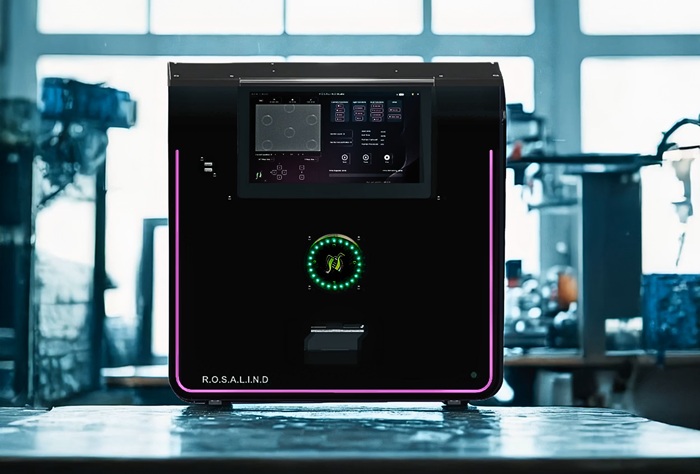Noninvasive Test Helps Identify Cause of Specific Kidney Disease
|
By LabMedica International staff writers Posted on 02 Jul 2014 |

Image: Histopathology of a kidney showing membranous glomerulonephritis (Photo courtesy of University of Utah).
The first test that can help determine a specific type of kidney disease, called membranous glomerulonephritis (MGN) has been authorized for marketing.
Membranous glomerulonephritis (MGN) is a chronic kidney disease that causes damage to the glomeruli, which are the cluster of tiny tufts of capillary blood vessels in the kidney that filter the blood and begin the process to remove waste and excess fluid from the blood.
The US Food and Drug Administration (Silver Springs, MD, USA) reviewed a clinical study of 560 blood samples of which 275 samples were obtained from patients with presumed primary MGN (pMGN), while 285 samples were obtained from patients diagnosed with other kidney diseases including secondary MGN (sMGM) and autoimmune diseases, not including pMGN, that can damage the kidney, like lupus erythematosus.
The EUROIMMUN Anti- PLA2R IFA blood test (Euroimmun US Inc.; Morris Plains, NJ, USA) detects if a patient has an antibody, a protein molecule the body’s immune system produces, that is specific to pMGN. The test was able to detect pMGN in 77% of the presumed pMGN samples, and gave a false positive result in less than 1% of the other disease samples. Notably, the test was helpful in distinguishing between pMGN from sMGN in most of the patients. The test should not be used alone to diagnose pMGN. Additional information, including patient symptoms and other laboratory tests, should always be considered when making a diagnosis of pMGN. A biopsy of the kidney is needed to confirm the diagnosis of pMGN. A negative result from the test does not rule out a diagnosis of pMGN.
Alberto Gutierrez, PhD, director of the Office of In Vitro Diagnostics at the FDA, said, “Treatment of MGN depends on the underlying cause of the disease. This test can help patients get a timely diagnosis for their MGN and aid with earlier treatment.” The FDA reviewed the EUROIMMUN Anti- PLA2R IFA blood test through its de novo classification process, a regulatory pathway for some novel low- to moderate-risk medical devices that are first-of-a-kind. The test should not be used to monitor the stage of disease or the response to treatment.
Symptoms of MGN include swelling, high cholesterol, high blood pressure and increased predisposition to blood clots. Over time, usually 10 to 20 years, some people with MGN proceed to kidney failure and require a kidney transplant. MGN affects mostly adult, Caucasian men. About 85% of MGN cases are caused by the body’s immune system mistakenly attacking healthy kidney tissue, which is one of the leading causes of kidney disease in adults.
Related Links:
US Food and Drug Administration
Euroimmun US Inc.
Membranous glomerulonephritis (MGN) is a chronic kidney disease that causes damage to the glomeruli, which are the cluster of tiny tufts of capillary blood vessels in the kidney that filter the blood and begin the process to remove waste and excess fluid from the blood.
The US Food and Drug Administration (Silver Springs, MD, USA) reviewed a clinical study of 560 blood samples of which 275 samples were obtained from patients with presumed primary MGN (pMGN), while 285 samples were obtained from patients diagnosed with other kidney diseases including secondary MGN (sMGM) and autoimmune diseases, not including pMGN, that can damage the kidney, like lupus erythematosus.
The EUROIMMUN Anti- PLA2R IFA blood test (Euroimmun US Inc.; Morris Plains, NJ, USA) detects if a patient has an antibody, a protein molecule the body’s immune system produces, that is specific to pMGN. The test was able to detect pMGN in 77% of the presumed pMGN samples, and gave a false positive result in less than 1% of the other disease samples. Notably, the test was helpful in distinguishing between pMGN from sMGN in most of the patients. The test should not be used alone to diagnose pMGN. Additional information, including patient symptoms and other laboratory tests, should always be considered when making a diagnosis of pMGN. A biopsy of the kidney is needed to confirm the diagnosis of pMGN. A negative result from the test does not rule out a diagnosis of pMGN.
Alberto Gutierrez, PhD, director of the Office of In Vitro Diagnostics at the FDA, said, “Treatment of MGN depends on the underlying cause of the disease. This test can help patients get a timely diagnosis for their MGN and aid with earlier treatment.” The FDA reviewed the EUROIMMUN Anti- PLA2R IFA blood test through its de novo classification process, a regulatory pathway for some novel low- to moderate-risk medical devices that are first-of-a-kind. The test should not be used to monitor the stage of disease or the response to treatment.
Symptoms of MGN include swelling, high cholesterol, high blood pressure and increased predisposition to blood clots. Over time, usually 10 to 20 years, some people with MGN proceed to kidney failure and require a kidney transplant. MGN affects mostly adult, Caucasian men. About 85% of MGN cases are caused by the body’s immune system mistakenly attacking healthy kidney tissue, which is one of the leading causes of kidney disease in adults.
Related Links:
US Food and Drug Administration
Euroimmun US Inc.
Latest Pathology News
- Rapid Low-Cost Tests Can Prevent Child Deaths from Contaminated Medicinal Syrups
- Tumor Signals in Saliva and Blood Enable Non-Invasive Monitoring of Head and Neck Cancer
- Common Health Issues Can Influence New Blood Tests for Alzheimer’s Disease
- Blood Test Formula Identifies Chronic Liver Disease Patients with Higher Cancer Risk
- Tunable Cell-Sorting Device Holds Potential for Multiple Biomedical Applications
- AI Tool Outperforms Doctors in Spotting Blood Cell Abnormalities
- AI Tool Rapidly Analyzes Complex Cancer Images for Personalized Treatment
- Diagnostic Technology Performs Rapid Biofluid Analysis Using Single Droplet
- Novel Technology Tracks Hidden Cancer Cells Faster
- AI Tool Improves Breast Cancer Detection
- AI Tool Predicts Treatment Success in Rectal Cancer Patients
- Blood Test and Sputum Analysis Predict Acute COPD Exacerbation
- AI Tool to Transform Skin Cancer Detection with Near-Perfect Accuracy
- Unique Immune Signatures Distinguish Rare Autoimmune Condition from Multiple Sclerosis
- Simple Optical Microscopy Method Reveals Hidden Structures in Remarkable Detail
- Hydrogel-Based Technology Isolates Extracellular Vesicles for Early Disease Diagnosis
Channels
Clinical Chemistry
view channel
POC Breath Diagnostic System to Detect Pneumonia-Causing Pathogens
Pseudomonas aeruginosa is a major cause of hospital-acquired and ventilator-associated pneumonia, particularly in lung transplant recipients and patients with structural lung disease. Its ability to form... Read more
Online Tool Detects Drug Exposure Directly from Patient Samples
Doctors often rely on patient interviews and medical records to determine what medications a person has taken, but this information is frequently incomplete. People may forget drugs they used, take over-the-counter... Read moreMolecular Diagnostics
view channel
Rapid Diagnostic Breakthrough Simultaneously Detects Resistance and Virulence in Klebsiella Pneumoniae
Antibiotic resistance is a steadily escalating threat to global healthcare, making common infections harder to treat and increasing the risk of severe complications. One of the most concerning pathogens... Read more
DNA Detection Platform Enables Real-Time Molecular Detection
A next-gen DNA detection platform enables real-time molecular detection by detecting nucleic acids directly without enzymes or thermocyclers, thereby slashing costs, reducing complexity, and boosting reliability... Read moreHematology
view channel
MRD Tests Could Predict Survival in Leukemia Patients
Acute myeloid leukemia is an aggressive blood cancer that disrupts normal blood cell production and often relapses even after intensive treatment. Clinicians currently lack early, reliable markers to predict... Read more
Platelet Activity Blood Test in Middle Age Could Identify Early Alzheimer’s Risk
Early detection of Alzheimer’s disease remains one of the biggest unmet needs in neurology, particularly because the biological changes underlying the disorder begin decades before memory symptoms appear.... Read more
Microvesicles Measurement Could Detect Vascular Injury in Sickle Cell Disease Patients
Assessing disease severity in sickle cell disease (SCD) remains challenging, especially when trying to predict hemolysis, vascular injury, and risk of complications such as vaso-occlusive crises.... Read more
ADLM’s New Coagulation Testing Guidance to Improve Care for Patients on Blood Thinners
Direct oral anticoagulants (DOACs) are one of the most common types of blood thinners. Patients take them to prevent a host of complications that could arise from blood clotting, including stroke, deep... Read moreMicrobiology
view channel
Breakthroughs in Microbial Analysis to Enhance Disease Prediction
Microorganisms shape human health, ecosystems, and the planet’s climate, yet identifying them and understanding how they are related remains a major scientific challenge. Even with modern DNA sequencing,... Read more
Blood-Based Diagnostic Method Could Identify Pediatric LRTIs
Lower-respiratory tract infections (LRTIs) are a leading cause of illness and death worldwide, and pneumonia is the leading infectious cause of death in children under five, claiming the lives of over... Read morePathology
view channel
Rapid Low-Cost Tests Can Prevent Child Deaths from Contaminated Medicinal Syrups
Medicinal syrups contaminated with toxic chemicals have caused the deaths of hundreds of children worldwide, exposing a critical gap in how these products are tested before reaching patients.... Read more
Tumor Signals in Saliva and Blood Enable Non-Invasive Monitoring of Head and Neck Cancer
Head and neck cancers are among the most aggressive malignancies worldwide, with nearly 900,000 new cases diagnosed each year. Monitoring these cancers for recurrence or relapse typically relies on tissue... Read more
Common Health Issues Can Influence New Blood Tests for Alzheimer’s Disease
Blood-based tests for Alzheimer’s disease are transforming diagnosis by offering a simpler alternative to spinal taps and brain imaging. However, many people evaluated at memory clinics also live with... Read more
Blood Test Formula Identifies Chronic Liver Disease Patients with Higher Cancer Risk
Chronic liver disease affects millions worldwide and can progress silently to hepatocellular carcinoma (HCC), one of the deadliest cancers globally. While surveillance guidelines exist for patients with... Read moreTechnology
view channel
Machine Learning Models Diagnose ALS Earlier Through Blood Biomarkers
Amyotrophic lateral sclerosis (ALS) is a rapidly progressive neurodegenerative disease that is notoriously difficult to diagnose in its early stages. Early symptoms often overlap with other neurological... Read more
Artificial Intelligence Model Could Accelerate Rare Disease Diagnosis
Identifying which genetic variants actually cause disease remains one of the biggest challenges in genomic medicine. Each person carries tens of thousands of DNA changes, yet only a few meaningfully alter... Read moreIndustry
view channel
BD and Penn Institute Collaborate to Advance Immunotherapy through Flow Cytometry
BD (Becton, Dickinson and Company, Franklin Lakes, NJ, USA) has entered into a strategic collaboration with the Institute for Immunology and Immune Health (I3H, Philadelphia, PA, USA) at the University... Read more




















